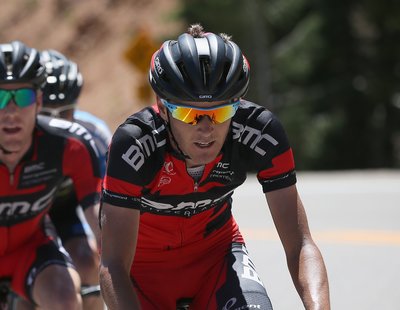
Race Radio: Stetina's Speedy Comeback, Murphy's Sprint
After every stage of this year's USA Pro Challenge, BMC's Peter Stetina has dismounted his bicycle and grabbed a cane to help him walk. Stetina is just four months removed from a scary crash that nearly ended his career.
 Peter Stetina spent this year’s USA Pro Challenge wowing his competitors both on and off the bike.
Peter Stetina spent this year’s USA Pro Challenge wowing his competitors both on and off the bike.
Stetina, 28, was one of Team BMC’s strongest domestique riders during the weeklong race, and shepherded overall winner Rohan Dennis up some of the longest climbs.
After each stage, however, Stetina dismounted his bicycle and grabbed a cane to help him walk into the BMC team bus. Stetina is just four months removed from a terrifying crash that nearly ended his cycling career. He’s spent four months enduring a painful physical therapy regimen to rehabilitate his leg. While he’s recovered enough to race his bicycle, Stetina still struggles to walk.
“It hurts more to walk than it does to ride,” Stetina said. “There’s definitely been some disbelief from the other guys.”
Stetina still cringes while replaying the crash. He was sprinting through the streets of Bilbao, Spain this past April in the waning moments of Stage 1 of the Tour of the Basque Country. About 400 meters from the finish line, the peloton swerved to avoid two three-foot high metal poles, which had not been removed from the road.
With no time to react, Stetina slammed into the poles while traveling at 35 miles per hour. His right leg took the brunt of the impact, before he careened into the pavement.
“The adrenaline was so high that I didn’t feel the pain at first,” says Stetina, 27. “I tried to get up and realized my leg didn’t work.”
The adrenaline wore off quickly, and suddenly a blinding pain shot through Stetina’s leg. The impact broke Stetina’s tibia, and nearly shattered his kneecap. Stetina says he remembers riding in the back of an ambulance with the dreaded feeling that his season — and perhaps his cycling career — could be over.
Immediately after the crash, Spanish surgeons put a plate into Stetina’s tibia and then reconstructed his kneecap. He spent 11 days in a Spanish hospital before flying back to his home in Santa Rosa, California.
After several weeks of healing, Stetina and his physical therapist began a daunting task. His injured knee had become stiff as a board due to an abundance of scar tissue. In order to regain his leg’s range of motion, Stetina and his doctor would have to break up that scar tissue. That required them to forcibly bend the leg.
“We would just bend it to a certain point, and I would almost black out from the amount of pain,” Stetina says. “Then they’d release it and massage it. Then we’d do it again.”
 Stetina underwent this treatment nearly every day for four months, and slowly forced the leg back to its normal range of motion He eventually got back onto his bicycle and began putting in the training miles. And after several months, his body had rebounded enough to begin cycling.
Stetina underwent this treatment nearly every day for four months, and slowly forced the leg back to its normal range of motion He eventually got back onto his bicycle and began putting in the training miles. And after several months, his body had rebounded enough to begin cycling.
When BMC’s Brent Bookwalter and then Rohan Dennis took over the yellow jersey this week, Stetina took on the task of riding at the front. He shredded the peloton on the run-in to Loveland Pass on stage 2. Eventually, however, the efforts led to a painful case of tendonitis, and Stetina abandoned the race midway through stage 6.
Still, Stetina sees his efforts as a victory. While he still cannot walk unsupported, he can support his team.
“I could have just ridden in the field and finished, but we got the [yellow] jersey and I wanted to help the guys,” Stetina says. “I think I’ve proved that it’s not if, but when I’ll be back to 100 percent.”
The Skills for the Sprint
Three of the seven stages at this year’s USA Pro Challenge finished with field sprints. The rush of the peloton toward the line is one of the most nail-biting and dangerous moments in cycling. Crashes are commonplace in these sprints. And a simple hesitation or touch of the brakes can separate a victory from defeat.
John Murphy, who won stage 7 into Denver, said winning a bunch sprint requires bravery, timing and the ability to steer through corners without braking. Teamwork, Murphy says, is perhaps the most important quality. In the waning meters of the race, Murphy’s teammate Marco Canolo pulled Murphy up to the wheel of Taylor Phinney, which allowed Murphy to win.
“Our team stays together as a unit,” Murphy says. “We communicate as much as you can at 190 heartbeats per minute. Even a grunt or an elbow flick can say a lot.”
About the author:
Fred Dreier is a journalist living in Denver, Colorado. He has written about professional bicycle racing since 2004, and his work has appeared in a wide variety of magazines and newspapers, such as The New York Times, The Wall Street Journal and USA Today. Dreier has covered the USA Pro Cycling Challenge since its debut in 2011. He regularly rides his bicycle on many of the roads used by the race.












